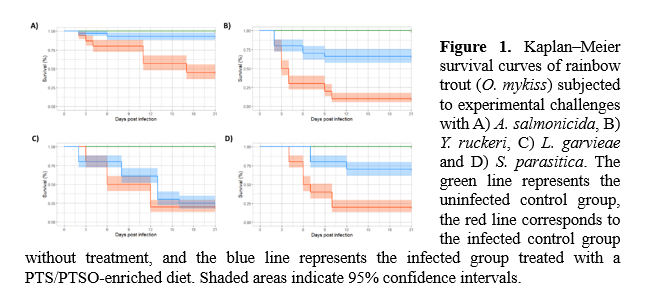ANTIMICROBIAL AND ANTIPARASITIC POTENTIAL OF ORGANOSULFUR COMPOUNDS FROM Allium cepa IN SALMONID AQUACULTURE
Introduction
The intensive production practices in salmonid aquaculture have led to significant health challenges, predominantly from bacterial, fungal, and parasitic infections (Tobback et al., 2009; Du et al., 2015; Wahli & Madsen, 2018 ; Shreves et al., 2024). Conventional use of antibiotics and antiparasitic treatments has raised global concerns regarding antimicrobial resistance and ecological sustainability (FAO/OIE/WHO, 2006) . This research aims to evaluate the efficacy of two organosulfur compounds, Propyl-Propane-Thiosulfinate (PTS) and Propyl-Propane-Thiosulfonate (PTSO), extracted from Allium cepa, as potential alternatives for managing these infections in rainbow trout (Oncorhynchus mykiss) and Atlantic salmon (Salmo salar).
Materials and Methods
In vitro assays, including disk-diffusion and Minimum Bactericidal/Fungicidal Concentrations (MBC/MFC), assessed antimicrobial and antiparasitic activities of PTS, PTSO, and their combination (PTS/PTSO). Pathogens tested included Yersinia ruckeri , Aeromonas salmonicida , Lactococcus garvieae, Piscirickettsia salmonis , and Saprolegnia parasitica . Antiparasitic efficacy was evaluated against adult Caligus rogercresseyi in controlled laboratory settings. Complementary in vivo studies involved dietary supplementation trials in rainbow trout to determine survival after pathogen infection.
Results
In vitro results showed substantial inhibitory activity against the targeted pathogens and parasites, with PTSO demonstrating consistently greater effectiveness compared to PTS. The combination of PTS/PTSO markedly reduced parasite viability, especially in early parasite developmental stages. In vivo dietary supplementation with PTS/PTSO significantly enhanced survival rates and decreased disease severity in challenged rainbow trout.
Conclusion
The findings underscore the promising antimicrobial and antiparasitic properties of PTS and PTSO, positioning these organosulfur compounds from onion as sustainable and effective alternatives for managing health issues in salmonid aquaculture. Further research is required to optimize delivery systems and compound stability under practical farming conditions.
References
Du, Y., Yi, M., Xiao, P., Meng, L., Li, X., Sun, G., & Liu, Y. (2015). The impact of Aeromonas salmonicida infection on innate immune parameters of Atlantic salmon (Salmo salar L). Fish & Shellfish Immunology, 44(1), 307–315. https://doi.org/10.1016/j.fsi.2015.02.029
Shreves, K. V., Saraiva, M., Ruba, T., Miller, C., Scott, E. M., McLaggan , D., & van West, P. (2024). Specific phylotypes of Saprolegnia parasitica associated with Atlantic salmon freshwater aquaculture. Journal of Fungi, 10(1), 57. https://doi.org/10.3390/jof10010057
Tobback , E., Decostere , A., Hermans, K., Ryckaert, J., Duchateau, L., Haesebrouck , F. & Chiers , K. (2009). Route of entry and tissue distribution of Yersinia ruckeri in experimentally infected rainbow trout (Oncorhynchus mykiss). Diseases of Aquatic Organisms, 84(3), 219-228. https://doi.org/10.3354/dao02057
Wahli, T., & Madsen, L. (2018). Flavobacteria, a never ending threat for fish: A review. Current Clinical Microbiology Reports, 5(1), 26–37. https://doi.org/10.1007/s40588-018-0086-x
(WHO) World Health Organization. (2006). Report of a joint FAO/OIE/WHO expert
consultation on Antimicrobial Use in Aquaculture and Antimicrobial Resistance.
World Health Organization. https://apps.who.int/iris/handle/10665/133869

